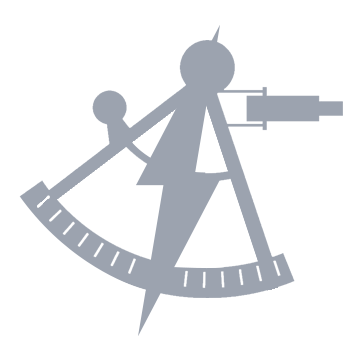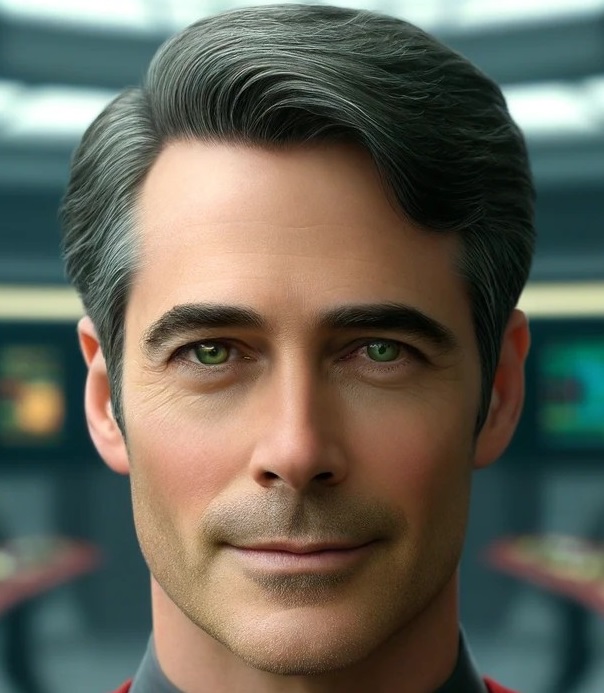The science annex aboard Deep Space Eleven was quiet at 0620—too quiet, even for Lieutenant Commander Harin’s standards. The bulkheads retained that early-morning chill and the faint thrum of plasma transfer through the station’s core systems had become the annex’s only company. He preferred it that way.
Harin stood alone at the primary subspace analysis console at the center of the annex, his long Denobulan fingers drumming absentmindedly against the side panel while his eyes tracked four overlapping signal spectrographs. The signal traces Loyo had passed to him weren’t much to look at—on the surface. But the numbers whispered. And Harin had spent a lifetime listening to whispers.
He scratched his chin thoughtfully, mumbling to himself in that meandering tone that only truly brilliant people could get away with.
“Too steady… too neat… ninety-seven-point-three intervals across a stabilized phase envelope.” He paused, tilting his head. “Subcarrier interference below 10⁻¹² Hz… that’s deeper than standard telemetry reflection. That’s… alignment.”
His fingers danced across the interface, launching a layered spectral decomposition across six dimensions. The trace bled out into a spiderweb of interconnected harmonics—clean, recursive, and deliberate. His brow furrowed.
“Mapping us,” he muttered. “But not from out there…”
He leaned in. The signal wasn’t just observing. It was reacting to the station’s own internal oscillations—tiny feedback loops from power regulators, EPS flows, and even the phase resonance of inertial dampeners.
“Computer,” Harin said quietly, “cross-reference harmonic interference vectors against internal power fluctuation logs for the last seventy-two hours.”
“Working…”
“MATCH FOUND – PRIMARY ENVIRONMENTAL CONTROL GRID (DECK 23, SECTOR C)
ANOMALOUS POWER USAGE: +0.02% DELTA OVER NOMINAL
TIME INDEX: 0300 HOURS (REPEATING PATTERN DETECTED)” The main computer reported.
Harin blinked. The room felt colder.
“Deck twenty-three? Environmental?” he said to no one. “Why would it touch that?”
The door to the annex slid open.
“You’ve been busy,” Commander Thorne said as she strode toward Harin.
“I was about to call you,” Harin replied. “It’s a harmonic fingerprint. Something is observing us without interacting—synchronizing itself with the station’s systems just enough to learn how they operate.”
“Learn how?” Thorne asked.
“Subspace resonance,” Harin said. “It’s shadowing our internal frequencies. Power converters, EPS taps, even inertial dampeners—everything that naturally vibrates or cycles. It’s like it’s trying to find our pulse… not to kill it, but to copy it.”
Thorne’s eyes narrowed. “You’re saying it’s inside?”
“I’m saying,” Harin replied, voice tight, “it doesn’t need to be. Not yet.”
She exhaled through her nose and paced a step toward the console. “Environmental controls on Deck Twenty-Three are showing minor deltas—steady power draws that don’t belong. Same time window as the signal’s peak alignment.
“Coincidence?”
Harin didn’t answer.
She didn’t wait for one.
“Get me a full phase-layer sweep from that section, quietly,” Thorne ordered.
“I’ll need access to auxiliary emitters.”
“You’ll have it.” She turned for the door, then hesitated. “And Harin?”
He looked up.
“Find out if this thing is waiting for something… or already here.”
“Aye, Commander.” Harin replied as the door closed behind Thorne.
“Computer. Begin an encrypted Level One diagnostic sweep. Sector C, Deck Twenty-Three. Target: environmental control junctions, access panels, and maintenance crawlspaces. Overlay phase resonance mapping. Full bandwidth. No notifications to Security or Engineering. Authorization Harin-delta-zero-four.”
“Working…”
He stepped away from the central console and toward the recessed station diagnostics alcove. The glow of the holodisplaysoftened, dimmed, and reconfigured into a live feed of Deck Twenty-Three’s environmental control junctions. Junction 23-C-17 flickered. Only briefly. But he saw it.
There was a harmonic smear, barely a ghost image, wrapped around the EPS conduit signature. A swirl of mismatched frequency echoed back at the station’s own systems with just enough variance to avoid triggering a conflict.
Like someone had mirrored part of the station.
Or installed a shadow of it.
“Impossible…” he whispered. “We’d know. Engineering would know.”
But the readings didn’t lie.
The resonance was stable and matched to within three decimal places. The variance curves suggested adaptive learning. Feedback conditioning. Something learning how the station thought.
Harin felt the bottom of his stomach go tight.
“Computer,” he said, slower now, “cross-reference that anomaly with recorded maintenance logs. Has there been any scheduled work on or near junction 23-C-17 in the last ten days?”
“Negative.”
“Any personnel logged entry into that compartment within the same period?”
“No personnel have entered compartment 23-C-17 in the past ten days.”
He stared at the feed. Something was operating inside a sealed environmental junction, and no one had gone in.
“Interesting,“ Harin muttered.
He began pulling up engineering schematics—power tap points, field modulation nodes, every place on Deck Twenty-Three that could theoretically bleed ambient subspace emissions back into the mainline infrastructure.
“Harin to Loyo.”
“Still on watch up here.”
“I need you to run down a local source of passive sensor bleeds on Deck Twenty-Three, compartment 23-C-17 “
“Only traffic down there has been automated system checks”, Loyo said.
“No civilian systems, either?”
“Negative.”
Harin’s brow furrowed. “Alright. Can you pull telemetry from every EPS spike in that sector for the past week? Overlay it with our signal harmonics and check for any phase drift patterns.”
“Acknowledged. Pulling the data now. Loyo out.”
Harin exhaled. The station wasn’t just being watched. It was being studied. Mirrored. Patterned. Something on—or just outside—the station was trying to understand how Deep Space Eleven lived, breathed, and powered itself.
The signal wasn’t a threat yet.
But it was getting closer to knowing how to become one.
___________________________________________________________________________
Sickbay aboard Deep Space Eleven maintained its own rhythm, separate from the station’s command cycle and shift rotations. The lighting was constant. Environmental controls kept the temperature a fraction warmer than standard, not by accident but by design. Commander Kellen Rourke believed healing began when the body stopped bracing for the cold.
At 0650, the compartment was quiet. No emergencies, just the soft chirp of monitors and the background murmur of biobed diagnostics running on standby.
Commander Rourke stood at his workstation, elbows resting on the edge, eyes narrowed at the personnel health logs scrolling across the screen. He was in his early fifties, tall but slightly hunched from years of surgical posture, with a square jaw and sharp eyes that scanned as efficiently as any tricorder. His uniform tunic was open at the collar—just enough to suggest this wasn’t his first day or his thousandth.
He rubbed at his chin, exhaled through his nose, and tapped a line on the display to freeze it.
Ensign T’Varin, an Environmental Systems Technician, had reported dizziness and auditory distortion during the previous shift. No field injury. No ongoing medication. No history of vertigo. Treated with hydration and released. But what drew Rourke’s attention wasn’t the complaint—it was the location.
Deck Twenty-Three, Sector C.
He keyed a quick search. Two more minor reports in the past ten days: one crewman from Maintenance Section Four citing persistent low-level nausea and a junior science officer who claimed to hear a “vibrating hum“ in their quarters—also located within the same zone. All logged, cleared, and ignored.
Rourke didn’t like patterns.
He liked them even less when they emerged from places labeled “nominal.”
The doors parted behind him.
“Commander?“ came the soft voice of Nurse Edra, a young Bolian with unshakable calm.
He turned slightly. “Morning, Edra.“
“We’ve got a follow-up from Gamma Shift. Ensign T’Varin again. Dizzy spells returned. She’s waiting in Bay Two.”
Rourke nodded once and turned off the display. “Vitals?”
“Stable. No trauma. Same symptoms.“
“Deck Twenty-Three?“
“Same assignment.”
Rourke straightened and walked with a deliberate pace toward Bay Two.
When he entered, T’Varin was sitting upright on the diagnostic bed, posture rigid in the way only Vulcans managed even when disoriented. Her hands were folded neatly in her lap.
“Ensign,“ Rourke greeted.
“Commander.“ Her voice was even, but her eyes tracked him with effort. “The vertigo has returned.”
He picked up a tricorder and began scanning. “Same location?“
“Yes. I was assigned to recalibrate the environmental dampeners near junction C-17.”
His eyes flicked up.
“You’ve worked that section all three nights?“
“I have. I did not report the first occurrence. It seemed… minor.“
“Until it wasn’t. You didn’t access the compartment?”
“Correct.”
The tricorder beeped softly. Nothing obvious—no cranial swelling, no abnormal electrical activity. But Rourke had seen too many clean scans in dirty situations.
He set the device down and met her eyes. “Ensign, I want you working off Deck Twenty-Three. Effective immediately.“
“That will interfere with scheduled—“
“It’s not a request, Ensign”
A beat. Then, she nodded.
He stepped back and thumbed his commbadge.
“Rourke to Commander Thorne.”
“Go ahead, Doctor.”
“I’ve got three separate crew with minor but persistent neurological symptoms. All tracked to Deck Twenty-Three, Sector C. Something’s bleeding into them—subspace, EM, I don’t know yet.“
“I’ll send you the data we have,“ Thorne replied.
“Quietly pull anyone else working that section. Thorne, out.”
“If something’s in the bulkeds, we’re already behind the curve.” Rourke said darkly.

 Bravo Fleet
Bravo Fleet










